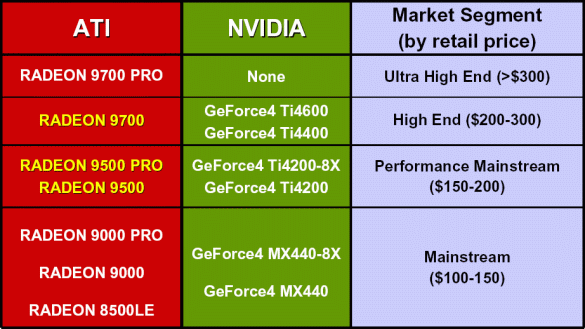ATI Increases Its Lead: The New Radeon 9700, 9500 PRO and 9500
Introduction, Continued
What does this mean in practical terms? The 9700 is certainly the most attractive, since it is a good $100 cheaper than the PRO but doesn't lose much on performance. Through the lower clock speed, the memory bandwidth is reduced from 19.2 GB/s to 17.6 GB/s. The fill rate sinks from 2.6 to 2.4 GPixel/s. With the 9500 PRO, the memory bandwidth decreases to 8.8 GB/s, due to the memory bus, which has been reduced to 128-bit. The fill rate (2.2 GPixel), however, is identical to that of the 9700. Compared to the "bigger" versions, this card is much slower, especially with bandwidth-gobbling anti-aliasing and anisotropic filtering.
With the 9500 (non-PRO version), the fillrate is reduced to 1.1 GPixel, due to the 4 pixel pipelines that have been left out. Here, you can expect dramatic slumps in performance. Because the pixel pipelines of the R300 can process only one pixel per pipe and clock cycle, the fill rate decreases by nearly half during multi-texturing, which is practically the standard nowadays in all of the new games. This will cause the 9500 to lag behind in games when compared to its main rival, NVIDIA GeForce 4 Ti 4200. NVIDIA's GeForce 4 Ti chip (NV25/28) also has only 4 pixel pipelines, but they are capable of calculating two pixels per pipe and cycle.
The new cards in detail:
| Header Cell - Column 0 | NVIDIA GeForce4 Ti4600 | ATI Radeon 9500 | ATI Radeon 9500 PRO | ATI Radeon 9700 | ATI Radeon 9700 PRO |
|---|---|---|---|---|---|
| Chip Technology | 256-bit | 256-bit | 256-bit | 256-bit | 256-bit |
| Process | 0.15 Micron | 0.15 Micron | 0.15 Micron | 0.15 Micron | 0.15 Micron |
| Transistors | 63 Mio | - | - | - | - |
| Memory Bus | 128-bit DDR | 128-bit DDR | 128-bit DDR | 256-bit DDR | 256-bit DDR |
| Memory Bandwidth | 10.4 GB/s | 8.8 GB/s | 8.8 GB/s | 17.6 GB/s | 19.2 GB/s |
| AGP Bus | 1x/2x/4x | 1x/2x/4x/8x | 1x/2x/4x/8x | 1x/2x/4x/8x | 1x/2x/4x/8x |
| Memory | 128 MB | 64 MB | 128 | 128/256 MB | 128/256 MB |
| GPU Clock | 300 MHz | 275 MHz | 275 MHz | 275 MHz | 325 MHz |
| Memory Clock | 325 MHz (650 DDR) | 270 MHz (540 DDR) | 270 MHz (540 DDR) | 270 MHz (540 DDR) | 310 MHz (620 DDR) |
| Memory | BGA 2.8ns | BGA | BGA | BGA | BGA |
| Vertex Shader | 2 | 4 | 4 | 4 | 4 |
| Pixel Pipelines | 4 | 4 | 8 | 8 | 8 |
| Texture Units Per Pipe | 2 | 1 | 1 | 1 | 1 |
| Textures per Texture Unit | 4 | 8 | 8 | 8 | 8 |
| Vertex S. Version | 1.1 | 2 | 2 | 2 | 2 |
| Pixel S. Version | 1.3 | 2 | 2 | 2 | 2 |
| DirectX Generation | 8 | 9 | 9 | 9 | 9 |
| FSAA Modi | MultiSampling | MultiSampling | MultiSampling | MultiSampling | MultiSampling |
| Memory Optmizations | LMA II | Hyper Z III | Hyper Z III | Hyper Z III | Hyper Z III |
| Display Outputs | 2 | 2 | 2 | 2 | 2 |
| Chip Internal Ramdacs | 2 x 400 MHz | 2 x 400 MHz | 2 x 400 MHz | 2 x 400 MHz | 2 x 400 MHz |
| Chip External Ramdacs | - | - | - | - | - |
| Bits per Color Channel | 8 | 10 | 10 | 10 | 10 |
| Special | - | TV Encoder On-Chip; FullStream | TV Encoder On-Chip; FullStream | TV Encoder On-Chip; FullStream | TV Encoder On-Chip; FullStream |
| Estimated Price | ~ $230-300Streetprice | $179 Official Price | $199 Official Price | $299 Official Price | $399 Official Price~ $315-350 Streetprice |
In terms of features, there are few differences to the 9700 PRO. According to the data sheets up to know, all cards will have dual-display support and have TV-out. And because the new video capture chip "Theater 200" is supported by all of the chip variants, it is to be expected that the board partners will also offer versions with TV-in.
Get Tom's Hardware's best news and in-depth reviews, straight to your inbox.
